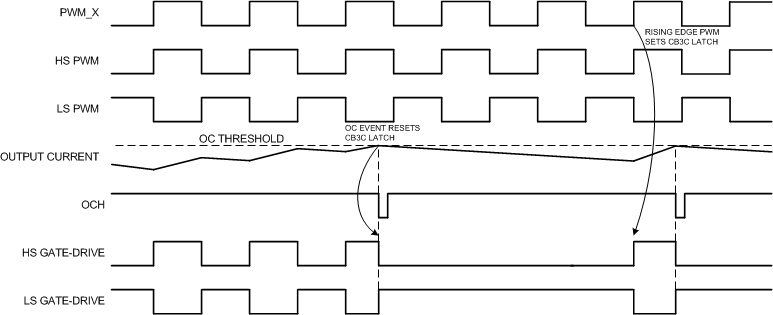ZHCSQ35 November 2022 TPA3223
PRODUCTION DATA
- 1 特性
- 2 应用
- 3 说明
- 4 Revision History
- 5 Device Comparison
- 6 Pin Configuration and Functions
- 7 Specifications
- 8 Parameter Measurement Information
-
9 Detailed Description
- 9.1 Overview
- 9.2 Functional Block Diagrams
- 9.3 Feature Description
- 9.4
Device Functional Modes
- 9.4.1 Powering Up
- 9.4.2 Powering Down
- 9.4.3 Device Reset
- 9.4.4 Device Soft Mute
- 9.4.5
Device Protection System
- 9.4.5.1 Overload and Short Circuit Current Protection
- 9.4.5.2 Signal Clipping and Pulse Injector
- 9.4.5.3 DC Speaker Protection
- 9.4.5.4 Pin-to-Pin Short Circuit Protection (PPSC)
- 9.4.5.5 Overtemperature Protection OTW and OTE
- 9.4.5.6 Undervoltage Protection (UVP), Overvoltage Protection (OVP), and Power-on Reset (POR)
- 9.4.5.7 Fault Handling
- 10Application and Implementation
- 11Device and Documentation Support
- 12Mechanical, Packaging, and Orderable Information
9.4.5.1 Overload and Short Circuit Current Protection
TPA3223 has fast reacting current sensors on all high-side and low-side FETs. To prevent output current from increasing beyond the overcurrent threshold, TPA3223 uses current limiting of the output current for each switching cycle (Cycle By Cycle Current Control, CB3C) in case of excess output current. CB3C prevents premature shutdown due to high output current transients caused by high level music transients and a drop of the real load impedance of the speaker, and allows the output current to be limited to a maximum programmed level. If the maximum output current persists, for example the power stage being overloaded with too low load impedance, then the device will shut down the affected output channel and the affected output is put in a high-impedance (Hi-Z) state until a RESET cycle is initiated. CB3C works individually for each full-bridge output. If an over current event is triggered, then the CB3C performs a state flip of the full-bridged output that is cleared upon beginning of next PWM frame.
 Figure 9-14 CB3C Timing Example
Figure 9-14 CB3C Timing Example